| Listing 1 - 7 of 7 |
Sort by
|
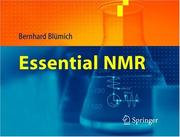
ISBN: 9783540236054 9783540271932 3540236058 Year: 2005 Publisher: Berlin, Heidelberg Springer-Verlag Berlin Heidelberg
Abstract | Keywords | Export | Availability | Bookmark
 Loading...
Loading...Choose an application
- Reference Manager
- EndNote
- RefWorks (Direct export to RefWorks)
ESSENTIAL NMR is a set of lecture notes for scientists and engineers who want to brush up on their knowledge of NMR. This book is also a compendium for graduate and postgraduate students of physics and chemistry as well as for their teachers, covering all fields of NMR, i.e. NMR methodology and hardware, chemical analysis, 2D-spectroscopy, NMR imaging, flow NMR, and quality control NMR. The material, selected and organized for a one-semester course, is presented with pairs of pages addressing particular topics. One page of each pair provides a text containing the key information, the other page shows a color illustration. This is the most comprehensive textbook on NMR to date. The book is intended for beginning graduate students and doctoral students of Physics, Chemistry, Chemical Engineering, and Material Science.
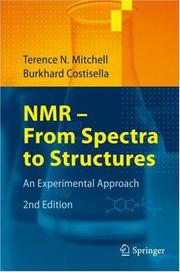
ISBN: 9783540721956 9783540721963 3540721959 Year: 2007 Publisher: Berlin, Heidelberg Springer-Verlag Berlin Heidelberg
Abstract | Keywords | Export | Availability | Bookmark
 Loading...
Loading...Choose an application
- Reference Manager
- EndNote
- RefWorks (Direct export to RefWorks)
Nuclear magnetic resonance spectroscopy is one of the most powerful analytical methods. This practice-oriented textbook aims at teaching how NMR experiments should be used to make structural asssignments. The book is intended as a practical guide for students and laboratory personnel, so that the emphasis is on practical rather than on theoretical aspects, which are treated only to the extent necessary to understand the experiments and to interpret the results. The second edition has been expanded to include several other heteronuclei (15N, 19F, 29Si, 77Se, 113Cd, 117Sn/119Sn, 195Pt, 207Pb) and a new chapter on solid state NMR. The problems section has been enlarged and now includes 50 problems. These are of different degrees of complexity and in all cases include two-dimensional (2D) methods as well as standard proton and carbon 1D spectra.
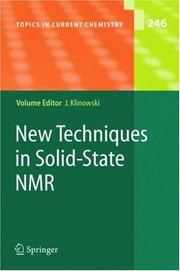
ISBN: 9783540221685 9783540314738 3540221689 Year: 2005 Publisher: Berlin Springer
Abstract | Keywords | Export | Availability | Bookmark
 Loading...
Loading...Choose an application
- Reference Manager
- EndNote
- RefWorks (Direct export to RefWorks)
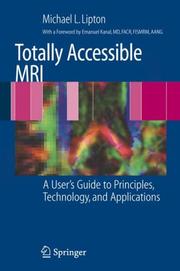
ISBN: 9780387488967 0387488952 9780387488950 0387488960 Year: 2008 Publisher: New York ; London : Springer,
Abstract | Keywords | Export | Availability | Bookmark
 Loading...
Loading...Choose an application
- Reference Manager
- EndNote
- RefWorks (Direct export to RefWorks)
This practical guide offers a lucid introduction to the principles of MRI physics. The author, recognized in the imaging community for his exceptional teaching methods and lectures, has written an easy to understand text. Each chapter explains the "why" and "how" behind MRI. Readers will understand how altering MRI parameters will have many different consequences for image quality and the speed in which images are generated. Practical topics, selected for their value to clinical practice, include progressive changes in key MRI parameters, imaging time, and signal to noise ratio. A wealth of high quality illustrations, complemented by concise text, enables readers to gain a thorough understanding of the subject without requiring prior in-depth knowledge.
Medicine & Public Health. --- Imaging / Radiology. --- Diagnostic Radiology. --- Medicine. --- Medical radiology --- Médecine --- Radiologie médicale --- Magnetic resonance imaging. --- Medical physics. --- Radiology, medical. --- Magnetic resonance imaging --- Tomography --- Diagnostic Imaging --- Diagnostic Techniques and Procedures --- Magnetic Resonance Imaging --- Diagnosis --- Analytical, Diagnostic and Therapeutic Techniques and Equipment --- Physics --- Medicine --- Health & Biological Sciences --- Physical Sciences & Mathematics --- Radiology, MRI, Ultrasonography & Medical Physics --- Electricity & Magnetism --- Clinical magnetic resonance imaging --- Diagnostic magnetic resonance imaging --- Functional magnetic resonance imaging --- Imaging, Magnetic resonance --- Medical magnetic resonance imaging --- MR imaging --- MRI (Magnetic resonance imaging) --- NMR imaging --- Nuclear magnetic resonance --- Nuclear magnetic resonance imaging --- Diagnostic use --- Radiology. --- Cross-sectional imaging --- Diagnostic imaging
Book
ISBN: 9783540791188 3540791175 9783540791171 3540791183 Year: 2008 Publisher: Berlin, Heidelberg : Springer Berlin Heidelberg : Imprint: Springer,
Abstract | Keywords | Export | Availability | Bookmark
 Loading...
Loading...Choose an application
- Reference Manager
- EndNote
- RefWorks (Direct export to RefWorks)
Nuclear Magnetic Resonance is a powerful tool, especially for the identification of 1 13 hitherto unknown organic compounds. H- and C-NMR spectroscopy is known and applied by virtually every synthetically working Organic Chemist. Con- quently, the factors governing the differences in chemical shift values, based on chemical environment, bonding, temperature, solvent, pH, etc. , are well understood, and specialty methods developed for almost every conceivable structural challenge. Proton and carbon NMR spectroscopy is part of most bachelors degree courses, with advanced methods integrated into masters degree and other graduate courses. In view of this universal knowledge about proton and carbon NMR spectr- copy within the chemical community, it is remarkable that heteronuclear NMR is still looked upon as something of a curiosity. Admittedly, most organic compounds contain only nitrogen, oxygen, and sulfur atoms, as well as the obligatory hydrogen and carbon atoms, elements that have an unfavourable isotope distribution when it comes to NMR spectroscopy. Each of these three elements has a dominant isotope: 14 16 32 16 32 N (99. 63% natural abundance), O (99. 76%), and S (95. 02%), with O, S, and 34 14 S (4. 21%) NMR silent. N has a nuclear moment I = 1 and a sizeable quadrupolar moment that makes the NMR signals usually very broad and dif cult to analyse.
Chemistry. --- Organic Chemistry. --- Organometallic Chemistry. --- Analytical Chemistry. --- Inorganic Chemistry. --- Polymer Sciences. --- Catalysis. --- Analytical biochemistry. --- Chemistry, inorganic. --- Chemistry, Organic. --- Polymers. --- Chimie --- Biochimie analytique --- Chimie organique --- Polymères --- Catalyse --- Electronic books. -- local. --- Nuclear magnetic resonance spectroscopy. --- Phosphorimetry. --- Biochemistry --- Analytical Chemistry --- Chemistry --- Physical Sciences & Mathematics --- Luminescence analysis --- Phosphorescence analysis --- Phosphorimetric analysis --- NMR spectroscopy --- Spectroscopy, NMR --- Spectroscopy, Nuclear magnetic resonance --- Analytical chemistry. --- Inorganic chemistry. --- Organic chemistry. --- Organometallic chemistry. --- Nuclear spectroscopy --- Knight shift --- Chemistry, Analytic --- Activation (Chemistry) --- Chemistry, Physical and theoretical --- Surface chemistry --- Polymere --- Polymeride --- Polymers and polymerization --- Macromolecules --- Inorganic chemistry --- Inorganic compounds --- Analytic biochemistry --- Organic chemistry --- Bioanalytic chemistry --- Bioanalytical chemistry --- Analytical chemistry --- Ressonància magnètica nuclear. --- Compostos orgànics --- Síntesi. --- Organometallic chemistry . --- Polymers . --- Analysis, Chemical --- Analytic chemistry --- Chemical analysis --- Chemistry, Organometallic --- Metallo-organic chemistry --- Chemistry, Organic --- Organometallic chemistry --- Polymers --- Catalysis
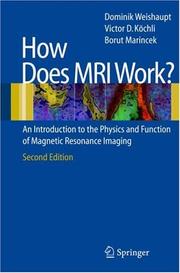
ISBN: 9783540300670 3540300678 9783540378457 9786610620593 3540378456 1280620595 1429420995 Year: 2006 Publisher: Berlin Springer
Abstract | Keywords | Export | Availability | Bookmark
 Loading...
Loading...Choose an application
- Reference Manager
- EndNote
- RefWorks (Direct export to RefWorks)
It is with great pleasure that we present this completely revised English e- tion of our book How Does MRI Work? An Introduction to the Physics and Function of Magnetic Resonance Imaging only two years afer publication of the frst English edition. We are particularly pleased that our introductory textbook met with great approval in the English-speaking world and not just in the German-speaking countries. Tis success has been an enormous - centive for us to further improve and update the text. For this reason, we are now presenting a second edition. All chapters have been thoroughly revised and updated to include the latest developments in the ever-changing feld of MRI technology. In particular, the chapter on cardiovascular imaging has been improved and expanded. We gratefully acknowledge the contribution of Daniel Nanz, PhD, the author of this chapter. Moreover, two completely new chapters have been added: “Fat Suppression Techniques” and “High- Field Clinical MR Imaging”. Notwithstanding these additions, the intended readership of our book remains the same: it is not a book for MR specialists or MR physicists but for our students, residents, and technologists, in short, all those who are interested in MRI and are looking for an easy-to-understand introduction to the technical basis of this imaging modality at the beginning of their MRI training. Te second English edition presented here corresponds to and appears together with the completely revised ffh German edition.
Magnetic Resonance Imaging --- Magnetic resonance imaging --- Imagerie par résonance magnétique --- 608.5 --- Medische beeldvorming --- MRI --- Radiologie --- Magnetic resonance imaging. --- Magnetic Resonance Imaging. --- Diagnostic Imaging --- Tomography --- Diagnostic Techniques and Procedures --- Diagnosis --- Analytical, Diagnostic and Therapeutic Techniques and Equipment --- Physics --- Medicine --- Physical Sciences & Mathematics --- Health & Biological Sciences --- Electricity & Magnetism --- Radiology, MRI, Ultrasonography & Medical Physics --- Clinical magnetic resonance imaging --- Diagnostic magnetic resonance imaging --- Functional magnetic resonance imaging --- Imaging, Magnetic resonance --- Medical magnetic resonance imaging --- MR imaging --- MRI (Magnetic resonance imaging) --- NMR imaging --- Nuclear magnetic resonance --- Nuclear magnetic resonance imaging --- Diagnostic use --- Medicine. --- Radiology. --- Condensed matter. --- Biophysics. --- Biological physics. --- Medicine & Public Health. --- Imaging / Radiology. --- Condensed Matter Physics. --- Biophysics and Biological Physics. --- Cross-sectional imaging --- Diagnostic imaging --- Radiology, Medical. --- Biological and Medical Physics, Biophysics. --- Clinical radiology --- Radiology, Medical --- Radiology (Medicine) --- Medical physics --- Biological physics --- Biology --- Medical sciences --- Condensed materials --- Condensed media --- Condensed phase --- Materials, Condensed --- Media, Condensed --- Phase, Condensed --- Liquids --- Matter --- Solids --- Radiological physics --- Radiation
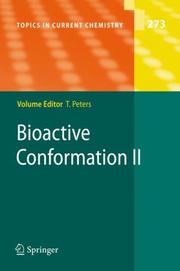
ISSN: 03401022 ISBN: 9783540490807 3540490795 9783540490791 3540490809 Year: 2008 Volume: 273 Publisher: Berlin Springer
Abstract | Keywords | Export | Availability | Bookmark
 Loading...
Loading...Choose an application
- Reference Manager
- EndNote
- RefWorks (Direct export to RefWorks)
Speci?c binding of a ligand to a receptor is a key step in a variety of biol- ical processes, such as immune reactions, enzyme cascades, or intracellular transport processes. The ligand-receptor terminology implies that the rec- tor molecule is signi?cantly larger than the ligand, and the term bioactive conformation usually characterizes the conformation of a ligand when it is bound to a receptor. In a more general sense, bioactive conformation applies toanymoleculeinabiologicallyrelevantboundstateregardlessofsizecons- erations. Mostofthecontributions tothisbookaddressligandsthat aremuch smaller than their receptors. X-ray crystallography and high resolution NMR spectroscopy are the two main experimental techniques used to study bioactive conformations. The- fore,the twovolumes ofthisbookcover approachesthat use either ofthetwo techniques, or a combination thereof. The combination of X-ray crystallog- phy and NMR spectroscopy is particularly useful when a crystal structure of areceptorprotein,butnotofthereceptorprotein-ligandcomplex,isavailable. Anumberofexperimentaltechniquestoanalyzethebioactiveconformationof aligandwithNMRarebasedontheobservationoftheresonancesignalsofthe free ligand that is in exchange with the bound ligand. Several chapters focus onsuchapproachesthat rangefromclassical transferredNOEexperiments, totransferred dipolar couplings,toSTD (saturation transfer difference) NMR techniques. Incaseswhere tightbinding inthesub-nanomolar rangeprevents the analysis of the bioactive conformation via free ligand signals, the ligand- proteincomplexhas tobeanalyzed withproteinNMR-based techniques orby crystallography.Sincethisareahasbeenthesubjectofmanyreviewsandmo- graphsitwill not be covered here in particular detail. As a unifying theme, all contributionstargetthequestionofhowmolecular recognitionofbiologically active molecules is achieved on the atomic scale. Depending on the research topic the results from these studies have a strong impact not only in basic research but also in several ?elds of application ranging frompharmaceutical applications tothe use of biomolecules as, for example, cryoprotectants.
Chemistry. --- Organic Chemistry. --- Biochemistry, general. --- Physical Chemistry. --- Medicinal Chemistry. --- Analytical Chemistry. --- Analytical biochemistry. --- Chemistry, Organic. --- Physical organic chemistry --- Biochemistry. --- Chimie --- Biochimie analytique --- Chimie organique --- Chimie organique physique --- Biochimie --- Conformational analysis --- Bioactive compounds --- Ligand binding (Biochemistry) --- Molecular Conformation --- Binding Sites --- Ligands --- Nuclear Magnetic Resonance, Biomolecular --- Protein Binding --- Analysis --- Chemistry --- Biochemistry --- Physical Sciences & Mathematics --- 577.354.3 --- Chemoreception --- 577.354.3 Chemoreception --- Conformational analysis. --- Analysis. --- Binding, Ligand (Biochemistry) --- Analysis, Conformational --- Biologically active compounds --- Compounds, Bioactive --- Compounds, Biologically active --- Compounds, Physiologically active --- Physiologically active compounds --- Analytical chemistry. --- Organic chemistry. --- Physical chemistry. --- Medicinal chemistry. --- Dye-ligand affinity chromatography --- Radioligand assay --- Molecular rotation --- Chemicals --- Chemistry, Physical organic. --- Analytic biochemistry --- Chemistry, Analytic --- Chemistry, Physical organic --- Chemistry, Organic --- Chemistry, Physical and theoretical --- Biological chemistry --- Chemical composition of organisms --- Organisms --- Physiological chemistry --- Biology --- Medical sciences --- Organic chemistry --- Composition --- Bioanalytic chemistry --- Bioanalytical chemistry --- Analytical chemistry --- Analysis, Chemical --- Analytic chemistry --- Chemical analysis --- Chemistry, Medical and pharmaceutical --- Chemistry, Pharmaceutical --- Drug chemistry --- Drugs --- Medical chemistry --- Medicinal chemistry --- Pharmacochemistry --- Chemistry, Theoretical --- Physical chemistry --- Theoretical chemistry --- Bioactive compounds - Analysis
| Listing 1 - 7 of 7 |
Sort by
|

 Search
Search Feedback
Feedback About UniCat
About UniCat  Help
Help News
News